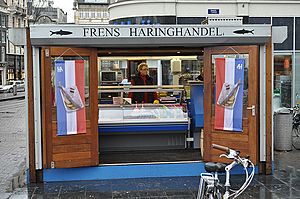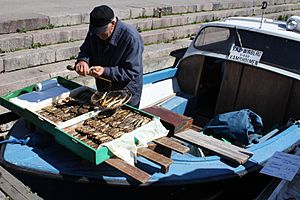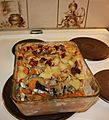Herring as food facts for kids
Herring are small, silvery fish that live in the ocean. They are a type of "forage fish," meaning they are a main food source for bigger fish, seabirds, and marine mammals. But herring are also a very important food for people all over the world!
Herring often swim together in huge groups called "schools." You can find these schools near the coast and in areas called "fishing banks," which are shallow parts of the ocean where fish gather. The most common types of herring belong to a group called Clupea. These are found in the cooler, shallow waters of the North Pacific and North Atlantic Oceans, including the Baltic Sea. They also live off the west coast of South America.
There are three main types of Clupea herring. The most important one is the Atlantic herring. This type makes up more than half of all the herring caught for food around the world. For a long time, herring have been a key part of fishing in Europe. Studying these fish helped scientists learn a lot about how to manage fisheries. Herring are also known as "oily fish" because they are full of healthy oils. People often prepare them by salting, smoking, or pickling them.
Contents
What's in Herring?
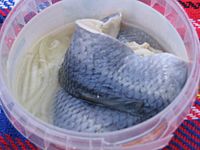 |
|
| Nutritional value per 100 g (3.5 oz) | |
|---|---|
| Energy | 661 kJ (158 kcal) |
|
0.0 g
|
|
| Sugars | 0.00 |
| Dietary fiber | 0.0 g |
|
9.04 g
|
|
|
Protein
|
17.96 g
|
| Vitamins | Quantity
%DV†
|
| Thiamine (B1) |
8%
0.092 mg |
| Riboflavin (B2) |
19%
0.233 mg |
| Niacin (B3) |
20%
3.217 mg |
| Pantothenic acid (B5) |
13%
0.645 mg |
| Vitamin B6 |
23%
0.302 mg |
| Folate (B9) |
3%
10 μg |
| Vitamin B12 |
570%
13.67 μg |
| Vitamin C |
1%
0.7 mg |
| Vitamin D |
28%
167 IU |
| Vitamin E |
7%
1.07 mg |
| Minerals | Quantity
%DV†
|
| Calcium |
6%
57 mg |
| Iron |
8%
1.10 mg |
| Magnesium |
9%
32 mg |
| Manganese |
2%
0.035 mg |
| Phosphorus |
34%
236 mg |
| Potassium |
11%
327 mg |
| Sodium |
6%
90 mg |
| Zinc |
10%
0.99 mg |
| Other constituents | Quantity |
| Water | 72 g |
|
Link to USDA Database entry
|
|
| †Percentages estimated using US recommendations for adults. | |
Raw Atlantic herring is mostly water (72%), with a good amount of protein (18%) and healthy fat (9%). It has no carbohydrates. A 100-gram serving of raw herring gives you about 158 calories.
Herring is an amazing source of vitamin B12. It also has a lot of niacin, vitamin B6, vitamin D, and phosphorus. Plus, it contains other B vitamins and zinc. Herring is especially good because it's full of healthy omega-3 fatty acids, which are important for your body.
How People Eat Herring
People have been eating herring for thousands of years, since at least 3000 B.C.! There are many different ways to prepare and serve this fish, and many countries have their own special recipes. Herring can be eaten raw, fermented, pickled, or cured in other ways.
Raw Herring
In the Netherlands, a special treat is Hollandse Nieuwe (Dutch New). This is raw herring caught in late spring and early summer. People usually eat it with raw onion. Hollandse Nieuwe is only fresh in the spring when the first herring of the season arrive. This is celebrated with festivals like the Vlaardingen Herring Festival. The herring is called "raw" because it's not cooked, but it has been lightly cured.
Salted Herring
Salting herring is a big business in Norway. In the past, herring was salted in wooden barrels and was a very important food source. Salted herring is used to make many other dishes, like spekesild.
Fermented Herring
In Sweden, people ferment Baltic herring to make a dish called surströmming.
Pickled Herring
Pickled herring is popular in German, Nordic, British, Canadian, Dutch, Polish, Baltic, and Jewish cooking. To pickle herring, it's first salted to remove water. Then, the salt is washed off, and the fish is put in a mix of vinegar, salt, and sugar. Other things like peppercorns, bay leaves, and onions are often added for flavor. You can also find pickled herring with sherry, mustard, or dill flavors. This tradition is very strong in places like Scandinavia, the Netherlands, Iceland, and Germany.
Dried Herring
In the Philippines, dried herring is a popular breakfast food. It's often eaten with garlic rice and eggs.
Smoked Herring
There are different types of smoked herring:
- A kipper is a herring that has been split open, cleaned, and cold-smoked.
- A bloater is a whole herring that hasn't been cleaned, but is cold-smoked.
- A buckling is a whole herring that's been cleaned (except for the roe or milt), and then hot-smoked.
All of these are traditional foods in British cuisine.
Smoked herring is also a traditional meal on the island of Bornholm and in Sweden.
Other Ways to Eat Herring
In Scotland, herring fillets are often coated in seasoned oatmeal and fried in a pan with butter or oil. This dish is usually served with boiled and buttered potatoes.
Herring soup is a traditional dish in Sweden.
In Southeast Alaska, people collect herring eggs that stick to western hemlock tree branches placed in the ocean. These fertilized eggs are then briefly boiled and eaten plain or in a herring egg salad. This way of collecting eggs is part of the traditional culture of the Tlingit people.
Herring Dishes Around the World
| Name | Image | Origin | Description |
|---|---|---|---|
| Avruga caviar |  |
Spain | Avruga is sold as a caviar substitute. It's made from herring (40%), salt, and other ingredients. It doesn't contain real fish roe. |
| Bloater |  |
England | A bloater is a whole herring that is lightly salted and cold-smoked. It's different from a kipper because it's smoked whole and not for as long. |
| Brathering | 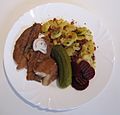 |
Germany | This is a dish of fried, marinated herring. Fresh herring are coated in flour, fried, and then pickled in a vinegar sauce with onions and spices. It's served cold with bread or potatoes. |
| Buckling |  |
European | A hot-smoked herring, similar to a kipper or bloater. The guts are removed, but the roe or milt stay inside. Buckling can be eaten hot or cold. |
| Dressed herring |  |
Russia | This is a layered salad with salted herring, boiled vegetables (potato, carrot, beet), and onions. It's topped with mayonnaise, which gives it a purple color. It's popular for New Year and Christmas. |
| Fischbrötchen (fish sandwich) |
 |
Germany | A sandwich with fish and onions, sometimes with pickles. It's often made with bismarck herring or soused herring. |
| Herring noodle |  |
Japan | Called Nishin-soba, this is a noodle dish with herring. |
| Herring roe | 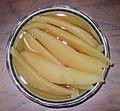 |
Japan | Called Kazunoko, herring roe is often served as part of Osechi for Japanese New Year. |
| Herring soup | Sweden | A traditional soup made with herring. | |
| Herring spawn |  |
Japan | Called Komochi-Kombu, this is herring spawn (eggs) on seaweed. It's often used in sushi. |
| Herring with mushrooms | Lithuania | A traditional Christmas Eve dish. Lithuanians have many ways to prepare herring. | |
| Kipper | United Kingdom | A whole herring that has been split open, cleaned, and cold-smoked. | |
| Pickled herring |  |
Northern Europe | Herring that has been preserved in a vinegar solution, often with spices and onions. |
| Rollmops |  |
Germany | A pickled herring fillet rolled around a piece of pickled gherkin or onion. |
| Śledzie |  |
Poland | Pickled herring mixed with chopped onions, hard-boiled eggs, apple, sour cream, and spices. It's a traditional Christmas Eve dish. |
| Solomon Gundy | 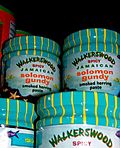 |
Jamaica | A spicy pickled fish pâté, often made with smoked herring. |
| Soused herring |  |
Netherlands | Fresh herring that has been cured in a mild vinegar solution, often eaten with raw onions. |
| Spekesild | 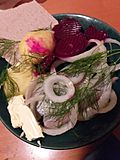 |
Norway | A traditional Norwegian dish of salted and filleted herring. It's often served with boiled potatoes, raw onions, pickled beets, butter, and flatbread. |
| Surströmming |  |
Sweden | Fermented Baltic herring, known for its very strong smell. |
| Vorschmack |  |
Ashkenazi Jews (Eastern Europe) | A chopped herring salad, often made with apples, onions, and bread. |
Images for kids
-
Bloaters on yellow paper, van Gogh, 1889


